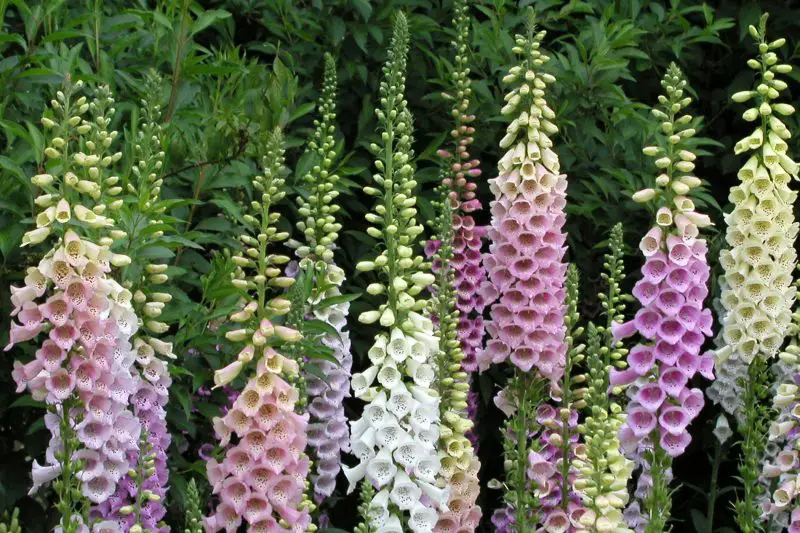Foxgloves enchant gardeners with their tall, bell-shaped flowers and dramatic vertical flair. These iconic spires, swaying gently in the breeze, add romance and old-world charm to any garden—whether they bloom for one season or return year after year is a common question among plant lovers.
In this guide, we’ll dive deep into the life cycle of foxglove, revealing whether it’s truly a perennial, biennial, or something in between. Along the way, you’ll learn how to extend its blooms, encourage reblooming, and create a garden filled with foxglove beauty season after season.
Understanding the Foxglove Life Cycle

While Digitalis purpurea—the most popular garden foxglove—is technically a biennial, its growth habit can easily confuse gardeners. In its first year, it forms a low rosette of soft green leaves. The second year brings the stunning vertical stalks of tubular blooms, after which the plant typically dies. But not all foxgloves follow this pattern. Perennial species like Digitalis grandiflora, Digitalis lutea, and Digitalis laevigata can return for several years, especially in mild climates with proper care and good drainage. These short-lived perennials may flower annually, though their vigor often diminishes over time.
Adding to the complexity is foxglove’s prolific self-seeding. Even when an individual plant dies, it often leaves behind a legacy of seedlings that emerge the following spring. As a result, gardens with established foxgloves may seem to host ever-blooming, perennial displays. This illusion of permanence comes not from a single plant’s longevity but from nature’s cycle of renewal through seed. Left to reseed naturally, foxgloves can grace your garden with continuous color for years to come.
Foxglove Varieties That Act Like Perennials
True Perennial Species
While most gardeners are familiar with biennial foxgloves like Digitalis purpurea, a lesser-known group within the genus consists of true perennials that offer longer-lasting performance. These include species such as Digitalis lanata (commonly known as woolly foxglove), Digitalis ferruginea (rusty foxglove), and Digitalis parviflora (small-flowered foxglove). These plants can thrive for three to five years or more, producing vertical spires of smaller but distinctive blooms in hues of cream, bronze, or copper.
These species are native to warmer or more temperate regions and perform best in climates with well-drained soil, moderate temperatures, and minimal root disturbance. Though their flower spikes may not be as large or colorful as those of biennials, their persistence in the landscape makes them valuable additions to perennial borders and wildflower-style gardens. They also require less reseeding effort and are favored by gardeners looking for dependable returns year after year.
Hybrid Cultivars
Thanks to modern plant breeding, several foxglove hybrids now offer perennial-like performance with the visual appeal of Digitalis purpurea. Cultivars like the ‘Camelot’, ‘Foxy’, and ‘Dalmatian’ series are bred to flower in their first year—a trait that makes them especially attractive to gardeners who don’t want to wait two years for blooms. These hybrids often behave like short-lived perennials, returning for two to three seasons under optimal conditions.
The ‘Camelot’ series, in particular, combines the stature and charm of traditional foxgloves with the convenience of quicker flowering. Meanwhile, ‘Foxy’ and ‘Dalmatian’ hybrids are compact, early-blooming options ideal for smaller spaces or containers. While not as long-lived as true perennials, these cultivars can mimic perennial growth habits when planted in well-prepared soil, deadheaded regularly, and protected from frost and root rot.
Whether you opt for species foxgloves or hybrid cultivars, choosing the right variety for your climate and garden design goals will determine how perennial your foxglove display truly becomes.
Growing Conditions That Support Perennial Behavior
Climate Considerations
Foxgloves are native to Europe and parts of western Asia, where the climate is generally cool and moist. As a result, they thrive in USDA hardiness zones 4 through 9, although success depends on the specific species and local microclimate. Biennial types like Digitalis purpurea handle light frosts well but may not survive harsh winters without mulch protection. True perennial species such as Digitalis ferruginea tend to be more resilient but can still struggle in prolonged heat.
In hot and humid climates like zone 9b or beyond, foxgloves may act more like annuals due to stress from heat. In these regions, providing afternoon shade, consistent moisture, and well-ventilated planting areas can help mitigate heat-related damage. Mulching also helps regulate soil temperature and moisture retention during warmer months.
Soil Requirements
Soil quality is a cornerstone of foxglove longevity. These plants prefer loamy or sandy soils with excellent drainage and ample organic matter. Compost or aged leaf mold can be mixed into the soil at planting time to improve fertility and moisture balance. Raised beds or gently sloped areas work well to prevent root rot, especially during rainy seasons.
Avoid planting foxgloves in clay-heavy or compacted soils unless they’ve been thoroughly amended. Good drainage is essential; stagnant water at the root level will quickly lead to fungal diseases or crown rot. A soil pH between 6.0 and 7.0 encourages nutrient uptake and robust root development, further supporting perennial behavior.
Light Preferences
Light plays a key role in both flowering and plant longevity. In cool northern climates, foxgloves can flourish in full sun, producing tall, richly colored spires. In contrast, southern or coastal regions with strong afternoon sun may cause leaves to scorch or flowers to fade prematurely. In these cases, filtered light or partial shade—especially after midday—is ideal.
A site with morning sun and dappled afternoon shade offers the best compromise for long-lasting performance. This light balance supports healthy foliage growth while preventing moisture stress, which is particularly important for perennial foxglove varieties. Avoid planting them under dense tree canopies where light competition is too high, as insufficient sunlight can reduce flowering and encourage leggy growth.
How to Keep Foxgloves Blooming Year After Year
Deadheading Spent Flowers
Deadheading—removing spent flower spikes—plays a key role in prolonging the blooming season of foxgloves. When a flower stalk finishes blooming, the plant naturally shifts energy into seed production, which can trigger dormancy or even the end of its life cycle, especially in biennial varieties. By promptly snipping off the fading blooms down to the next set of leaves or side shoots, you encourage the plant to focus on forming more flower spikes or maintaining healthy foliage. For perennial and hybrid types, consistent deadheading can lead to a longer blooming window and help extend the plant’s overall lifespan.
Cutting Back After Flowering
Once the primary blooming cycle ends, cutting back foxgloves helps rejuvenate the plant. Use clean, sharp pruners to remove the entire spent flower stalk and any yellowing or damaged leaves. This cleanup not only improves the garden’s appearance but also reduces the risk of fungal disease. In perennial and hybrid foxgloves, cutting back to the basal rosette (the low-growing clump of leaves) can stimulate vigorous vegetative growth, and in some cases, produce a second round of smaller flowers in late summer or early fall—particularly in temperate regions with mild weather.
Mulching and Winter Protection
Perennial foxgloves, especially in zones with frosty winters, benefit greatly from an insulating layer of mulch. Apply a 2–3 inch layer of organic mulch—such as straw, shredded bark, or compost—around the root zone in late autumn, after the first hard frost. This blanket protects the crown from freeze-thaw cycles that can damage roots and kill overwintering buds. In addition to preserving root health, mulch also suppresses early spring weeds and retains soil moisture. For extra protection in regions with severe winters, consider covering the rosette with evergreen boughs or frost cloth to buffer against drying winds and fluctuating temperatures.
Propagation Tips for Lasting Displays
Letting Plants Self-Seed
Letting foxgloves self-seed is one of the easiest ways to ensure blooms return year after year, especially for biennial types. After the flowering period, simply allow a few of the tallest, healthiest flower spikes to mature fully and set seed. As the seed pods dry and open, they scatter tiny seeds around the base of the plant and beyond. These seeds often germinate naturally in late summer or the following spring, forming new rosettes that will bloom the next season. This approach creates a “rolling” display of foxgloves that mimics perennial behavior, especially when timed and managed thoughtfully.
Collecting and Sowing Seeds
If you want to direct where and how your foxgloves grow—or want to try specific cultivars—collecting seeds is a smart strategy. Wait until the seed pods on faded spikes turn brown and brittle. Then snip them off and shake the tiny seeds into a paper envelope. Store them in a cool, dry place until you’re ready to sow. For best results, sow seeds in late summer or early fall in trays or directly in well-prepared garden soil. Lightly press the seeds into the surface—they need light to germinate—and keep them moist. This timing gives young plants enough time to establish roots before winter, setting the stage for strong growth and flowering the following year.
Dividing Perennial Clumps
Some foxglove species, such as Digitalis grandiflora or Digitalis lutea, are true perennials and can be divided every 2 to 3 years. In early spring or after flowering, dig up the clump carefully and separate the root mass into smaller sections, making sure each division has both roots and green shoots. Replant the divisions immediately in well-draining soil, spacing them appropriately to prevent overcrowding. Dividing not only revitalizes older clumps that may have become woody or sparse but also provides you with free plants to expand your display elsewhere in the garden. This method is ideal for maintaining consistent bloom quality and vigor over time.
Common Problems That Affect Longevity
Root Rot
Root rot is a common issue caused by overwatering or poor drainage. It leads to dark, mushy roots and drooping leaves. If left unchecked, the plant may die. To prevent this, grow foxgloves in well-draining soil. Improve heavy clay with compost, sand, or perlite. Avoid watering when the soil is still moist. Raised beds or sloped areas help excess water drain away from the roots.
Pests and Diseases
Foxgloves are vulnerable to aphids, slugs, and fungal diseases. Aphids feed on sap and can spread viruses. Slugs chew large holes in leaves, especially in damp conditions. Fungal problems like powdery mildew and leaf spots thrive when airflow is poor. Check your plants often, especially after rain. Remove damaged leaves, and space plants well to improve air circulation. Use organic controls like insecticidal soap, neem oil, or beer traps for slugs.
Poor Flowering
If your foxgloves aren’t blooming well, light, soil, or spacing may be to blame. They need morning sun and light afternoon shade. Nutrient-poor soil can also lead to weak flowering. Enrich the soil with compost and make sure plants aren’t overcrowded. Thin or divide clumps if needed. Apply a balanced or phosphorus-rich fertilizer in early spring to promote healthy blooms. Fixing these issues will lead to more flowers and longer-lasting plants.
Are Foxgloves Worth the Effort?
For gardeners who crave dramatic vertical color and a touch of the wild cottage garden charm, foxgloves are absolutely worth growing. These towering spires of bell-shaped blooms bring elegance, texture, and pollinator activity to any flower bed. While some may hesitate because foxgloves are often biennials or short-lived perennials, their rewards far outweigh the effort.
Stunning Visual Impact
Few plants match the striking beauty of foxgloves in full bloom. Their tall flower spikes—often reaching up to 5 feet—create a focal point that draws the eye and adds vertical interest. With colors ranging from soft cream to vibrant pinks and deep purples, foxgloves blend beautifully with other early summer flowers. Even when not in bloom, their rosettes of foliage offer lush greenery that enhances garden texture.
Support for Pollinators
Foxgloves are magnets for pollinators. Bees, especially bumblebees, are frequent visitors, drawn to the tubular shape of the flowers. By planting foxgloves, you’re not just beautifying your landscape—you’re actively supporting local ecosystems. Some gardeners even report more productive vegetable gardens nearby thanks to increased pollinator traffic.
Minimal Maintenance When Established
Once foxgloves find their place in the garden, they often take care of themselves. Biennial varieties tend to self-seed freely, forming a cycle of new plants that bloom each year without intervention. Perennial types, such as Digitalis grandiflora and Digitalis lutea, require even less fuss, coming back reliably year after year with minimal division or pruning.
Flexible in Design
Foxgloves are incredibly versatile. They fit well in cottage gardens, woodland borders, pollinator patches, or as a dramatic backdrop in mixed perennial beds. You can group them in drifts for a natural look or space them strategically for vertical accents. Their ability to thrive in both full sun and partial shade makes them adaptable to many garden styles and site conditions.
A Plant with History and Symbolism
Beyond their beauty, foxgloves carry rich folklore and symbolism. Often associated with fairies, healing (and sometimes poison), they evoke a sense of magic and old-world charm. Growing foxgloves adds not just color, but a story to your garden—something that sparks conversation and admiration.
A Small Learning Curve, Great Rewards
Yes, foxgloves may require some initial planning—especially if you’re managing biennial life cycles or ensuring proper spacing and drainage. But once you understand their rhythm, foxgloves become one of the most rewarding plants to grow. Their low-maintenance nature, combined with showstopping beauty, makes them a wise choice for gardeners who want lasting impact without constant effort.
Expert Gardening Tips for Stunning Foxglove Displays
Staggered Planting
One of the most effective techniques to enjoy foxglove blooms over a longer period is staggered planting. By sowing seeds or transplanting seedlings at different intervals—every two to three weeks during spring—you can ensure a rolling bloom cycle. As the first group begins to fade, the next will begin flowering, maintaining a continuous show of color. This method works particularly well with biennial varieties, which typically flower in their second year. To take full advantage, start some seeds indoors while directly sowing others outside to maximize bloom timing.
Companion Planting
Foxgloves are naturally suited to cottage-style and woodland gardens, but they truly shine when paired with complementary plants. For a harmonious display, grow them alongside tall, spiky flowers such as delphiniums or larkspur. Peonies offer lush, rounded blossoms that contrast beautifully with foxglove’s vertical spires, while alliums add structural interest and help deter pests. Ground-hugging perennials like lady’s mantle or hostas can mask fading foxglove foliage after blooming. These thoughtful pairings not only enhance aesthetics but also support pollinator diversity, attracting bees, butterflies, and hummingbirds.
Regular Soil Amendments
Healthy soil is the foundation of vigorous, long-lasting foxglove displays. These plants prefer slightly acidic to neutral soil that is rich in organic matter. To maintain optimal conditions, amend your garden beds annually with well-rotted compost, leaf mold, or aged manure. In early spring, apply a balanced, slow-release fertilizer to support foliage and flower stalk development. For tired or compacted soil, consider incorporating perlite or coarse sand to improve drainage. A consistent regimen of soil improvement helps foxgloves grow taller, bloom longer, and self-seed more reliably, giving you beautiful results year after year.
FAQs About Foxgloves Answered
Are all foxgloves perennials?
No, not all foxgloves are perennials. The most common type, Digitalis purpurea, is a biennial, meaning it grows foliage the first year and flowers in the second. Some species, like Digitalis grandiflora and Digitalis lutea, are true perennials and bloom year after year. It’s important to check the species when buying seeds or plants.
Can foxgloves survive winter?
Yes, many foxgloves can survive winter, especially perennial varieties. They go dormant in cold months and return in spring. Biennials also overwinter as rosettes and flower in their second year. In colder climates, a layer of mulch helps protect roots from freezing.
Are foxgloves toxic to pets?
Yes, foxgloves are highly toxic to both pets and humans. All parts of the plant contain cardiac glycosides that can affect the heart. Even small amounts can cause serious symptoms like vomiting, irregular heartbeat, or worse. Avoid planting near areas where dogs or cats roam freely.
Do foxgloves reseed themselves?
Yes, foxgloves reseed easily. Biennials often drop seeds after flowering, and those seeds sprout the next year, creating a natural cycle of blooming plants. If you let some flower spikes go to seed and leave the soil undisturbed, you may enjoy foxgloves for years without replanting.
How can I encourage more blooms from foxgloves?
To get more blooms, grow foxgloves in moist, well-drained soil and partial shade. Deadhead spent flowers to encourage side shoots. Feed with a balanced or phosphorus-rich fertilizer in early spring. For biennials, stagger planting every year to ensure continuous flowering in your garden.
Final Thoughts on Foxglove Longevity
While many foxglove varieties are technically biennial, their ability to self-seed and the availability of perennial species and hybrids offer gardeners the chance to enjoy their stunning blooms for many years. With proper care, thoughtful planting, and some expert tricks, you can make foxgloves a lasting presence in your garden.
Whether you’re growing classic Digitalis purpurea or branching into hardy perennial species, foxgloves will reward your efforts with towers of color and elegance each growing season.






